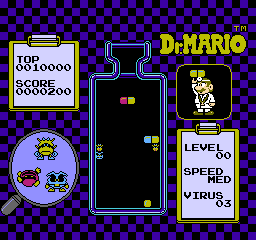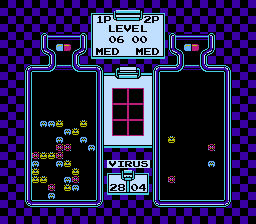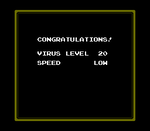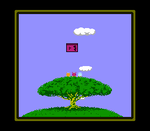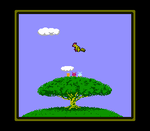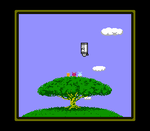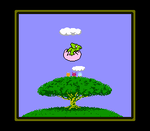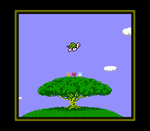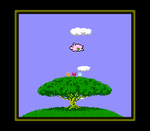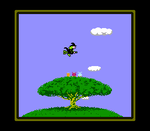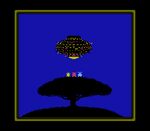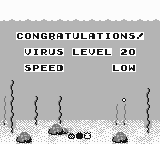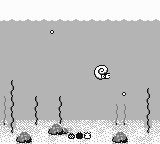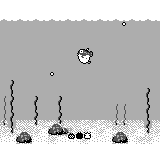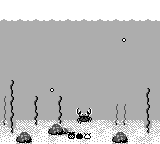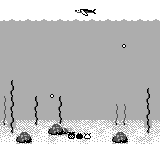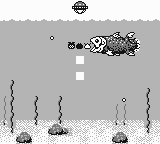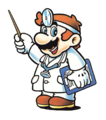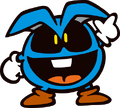Dr. Mario (game)
- This article is about the NES and Game Boy games. For the Nintendo 64 game known as simply "Dr. Mario" in Nintendo Puzzle Collection, see Dr. Mario 64. For other uses, see Dr. Mario (disambiguation).
| Dr. Mario | |||||||||||||||
|---|---|---|---|---|---|---|---|---|---|---|---|---|---|---|---|
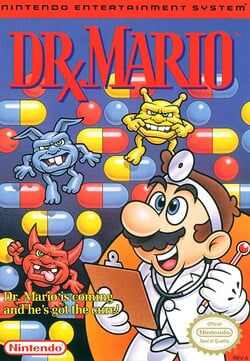 NES box art 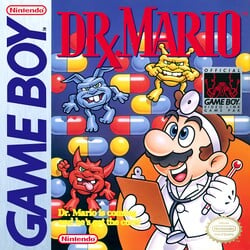 Game Boy box art For alternate box art, see the related gallery. | |||||||||||||||
| Developer | Nintendo R&D1 | ||||||||||||||
| Publisher | Nintendo | ||||||||||||||
| Platforms | Family Computer, Nintendo Entertainment System, Game Boy, PlayChoice-10, LodgeNet, Super Famicom, Game Boy Advance, Virtual Console (Nintendo 3DS, Wii U), NES Classic Edition, Nintendo Classic Mini: Family Computer, Nintendo Entertainment System - Nintendo Classics, Game Boy - Nintendo Classics | ||||||||||||||
| Release dates | Family Computer: Nintendo Entertainment System: Game Boy:
Nintendo PlayChoice-10:
LodgeNet: Game Boy (Player's Choice): Super Famicom (Nintendo Power): Game Boy (Nintendo Power): Game Boy Advance: Virtual Console (3DS): Virtual Console (Wii U): Nintendo Classic Mini: Family Computer: NES Classic Edition: Nintendo Entertainment System - Nintendo Classics: Nintendo Entertainment System - Nintendo Classics (The UFO cover-up): Game Boy - Nintendo Classics: | ||||||||||||||
| Language | English | ||||||||||||||
| Genre | Puzzle | ||||||||||||||
| Ratings |
| ||||||||||||||
| Mode | 1–2 players | ||||||||||||||
| Format | Arcade:
Built-in Famicom:
NES:
SF Memory Cartridge:
Super NES: Wii U: Nintendo Switch: Game Boy:
GB Memory Cartridge:
Game Boy Advance: Nintendo 3DS: NES Classic Edition:
Built-in
| ||||||||||||||
| Input | Famicom:
NES:
Wii U: Nintendo Switch: Game Boy:
Game Boy Advance: Nintendo 3DS: NES Classic Edition:
| ||||||||||||||
| Serial codes | Famicom: Game Boy: DMG-VUA Game Boy Advance: | ||||||||||||||
- “Dr. Mario, with germs that are fun to catch.”
- —US box blurb
Dr. Mario (stylized as D℞. MARIO on the Western logo) is an arcade-style puzzle video game created by Nintendo, and it was released for the Family Computer and Nintendo Entertainment System along with the Game Boy in 1990. The gameplay is very similar to that of Tetris, although in Dr. Mario, the object is to line up vitamins to destroy viruses.
Story[edit]
The following text is taken directly from the instruction manual.
Hi everybody! I'm Mario. How's it going? Over the last few years, I've been involved in some pretty wild adventures. Now, believe it or not, I work in the virus research lab at the Mushroom Kingdom Hospital. Today I'm about to begin my research as usual.
"Dr. Mario, something terrible has happened!"
"What's wrong, nurse Toadstool?" "One of the experiments has gone out of control. The viruses are spreading quickly!"
"Oh No! We've got to do something! I have just developed a new vitamin that should be able to take care of it. I sure hope this stuff works!"
Dr. Mario works in a virus research lab at the Mushroom Kingdom Hospital, alongside Nurse Toadstool. When one of the experiments goes wrong, the hospital is flooded with tri-color viruses. Armed with vitamin capsules—a medicine of his own invention—Dr. Mario sets out to neutralize the outbreak.
Gameplay[edit]
In this game, the interface is presented with a giant bottle, which features a grid that is 8 tiles long and 16 tiles tall. When the stage starts, viruses will populate the bottle, and they come in three varieties: Chill (blue), Fever (red), and Weird (yellow).
The main objective of the game is to clear the viruses in the bottle. This objective can be fulfilled with the help of multi-colored capsules called vitamin capsules. The vitamins have two segments, where each half can come in three colors, and both halves can even have the same color. To eliminate a virus with them, they must be lined up with at least one like-colored virus in a column or row so that the line consists of at least four in a row or column. When that happens, both the viruses and vitamins in that line disappear. These vitamins can also be cleared if four or more of the same colored pieces are arranged in a line, even if there are no viruses within them. The viruses remaining is represented by the three viruses under the magnifying glass around the bottom-left, where they slowly revolve along the glass. If at least one virus is eliminated, the corresponding virus color will flinch and the viruses will stop moving. If all viruses of that color are gone from the bottle, that corresponding virus under the glass will also disappear after flinching. After a number of vitamins are brought to the bottle, a five-note chime will be played which will signify that the speed of the capsule drops increased.
If vitamins are stacked so that one of the two middle spots at the top of the bottle is occupied, the player receives a Game Over.
Controls[edit]
/
: Move cursor on the menu screen
/
(left/right): Move vitamin capsule
/
(down): Drop vitamin capsule
/
: Rotate vitamin capsule clockwise
/
: Rotate vitamin capsule counterclockwise
/
: Start the game; pause or unpause game during gameplay
/
: Move cursor on the title screen
Characters[edit]
Game modes[edit]
1-Player Game[edit]
When a 1-Player game is started, the player has three options: Virus Level, Speed, and Music Type. For Virus Level, one of the 21 levels (from 0 to 20) can be chosen. This determines the number of viruses at the beginning is equal to four times the level number plus four, all the way up to level 20. Although the level number can go up to 24 in the Family Computer and Nintendo Entertainment System version, there will always be 84 viruses at the beginning of levels 20 and above.[12] In the Game Boy version, levels above 20 may be arranged in a way that is impossible to beat. Level 28 is a kill screen in which Mario does not appear.
The Speed setting determines the speed of the vitamins as they fall, which are between: Low, Med (medium), or Hi (high). The Music Type is a choice between Fever, Chill, or Off (no music). For the Game Boy version, the music can be previewed by highlighting the option, whereas this feature is not present in the Family Computer and Nintendo Entertainment System version.
In a 1-Player Game, the score is tracked. In order to earn points, viruses must be eliminated, as just clearing only capsules or forcefully dropping capsules will not contribute to the score. The amount of points earned from eliminating viruses is dependent on the Speed setting, where the base score is 100 for Low, 200 for Med, and 300 for Hi. Additionally, if the player eliminates more than one virus in a single move, the subsequent viruses contribute more points. After clearing all the viruses and finishing the level, the score is carried over to the next level. The basic scoring is as follows:
| Virus # | Low | Med | Hi |
|---|---|---|---|
| 1 | 100 | 200 | 300 |
| 2 | 200 | 400 | 600 |
| 3 | 400 | 800 | 1200 |
| 4 | 800 | 1600 | 2400 |
| 5 | 1600 | 3200 | 4800 |
| 6+ | 3200 | 6400 | 9600 |
In the Famicom and NES version, a fanfare will not sound after clearing more than one line in a single move. However in the Game Boy version, a fanfare will be played depending on the amount of lines made, and a special fanfare is played after clearing four or more lines in a single move, something that is not present in other versions.
2-Player Game[edit]
A 2-Player Vs. game mode is also available for selection. In this mode, two players battle to either clear their grid first, or cause their opponent to get a Game Over through causing an object to reach the middle of the topmost row. The game ends after one of the players wins three rounds. The Level and Speed options are chosen independently by each player before the game begins. For the Game Boy version, a Game Link cable is required to play the 2-player Vs. game mode. On the 3DS Virtual Console version, 2-player mode is not supported.
During a two-player head-on-head game, whenever a vitamin resulted in a chain or combo with more than one line cleared, a corresponding number of garbage, basically single vitamin pieces of colors based on the colors cleared by a player, will drop into their opponent's bottle at a slow pace, similar to the speed of a capsule falling normally in the Hi speed. The number of garbage that drops depends on the amount of lines cleared, so for example, clearing two lines in a move will cause two pieces to fall. The dropped pieces will simultaneously be either in the odd-numbered columns or even-numbered columns. If two pieces drop, both of them are always four columns apart, and if three pieces drop, they will all be two columns apart of each other and won't be two pieces that will be four columns apart.
Cutscenes[edit]
After completing certain levels at certain speeds, a short cutscene will occur, along with text that consists of a "CONGRATULATIONS!" message and the Virus Level and Speed that the player has beaten. The cutscenes are different between the Famicom and NES version and the Game Boy version. If the cutscene has something that moves in it, the text on the screen will disappear or appear depending on the version: they appear before the cutscene is played in the Famicom and NES version, whereas they start to appear after the cutscene is played in the Game Boy version.
Famicom / NES[edit]
Most of the cutscenes start with the viruses sitting on a tree. Graphics for a snowman and a round ball exist that are likely used in a cutscene, but they ended up unused.[13]
Game Boy[edit]
Every cutscene starts with the viruses sitting at the sea floor.
Reception[edit]
The Game Boy version of the game was placed 45th in the 100th issue of Nintendo Power's "100 best Nintendo games of all time" in 1997.[14] The Famicom and NES version placed 69th in the 200th Issue of GameInformer's "Top 200 Games of All Times". The game placed 51st in IGN's Top 100 NES Games list.[15]
Reviews for the game were generally positive, although there has been some criticism from parents about the medicine in a children's game. ACE in particular was more negative, giving the Game Boy version 510/1000, criticizing the repetitive gameplay and uninspired graphics. They also stated that the game "reeks of plagarism", stating that it was worse than the original games it was modeled after.[16] GameRankings gave the game 69.25%, while review aggregator Metacritic gave it a 66 out of 100 based on 10 reviews.
Remakes and ports[edit]
VS. Dr. Mario[edit]
- Main article: VS. Dr. Mario
In 1990, Dr. Mario was made available for the VS. System arcade machine under the name VS. Dr. Mario. This version omits the Low speed and renames the Med (medium) speed to Norm (normal), and has varied scoring values.
Satellaview[edit]
- Main article: Dr. Mario BS Ban
A slightly altered version of Dr. Mario, known as Dr. Mario BS Ban (Dr.マリオBS版), was broadcast for the Satellaview system between March 1997 and June 2000, using the same graphics and music as the Tetris & Dr. Mario version.
LodgeNet[edit]
This section is about a work that used to be available to the public, but is now partially or entirely inaccessible. Details: As per The Cutting Room Floor,[17] the LodgeNet version is not dumped.
However, the subject is thoroughly documented here. Only remove this notice if the complete work is recovered and made available publicly.
In the late 1990s, Dr. Mario was made available for the LodgeNet, both as a stand-alone release and in Tetris & Dr. Mario. The former is reported to be the same as the Nintendo Power version, but both releases have not been dumped.
List of re-releases and ports[edit]
- 1990: Dr. Mario was made available for the Nintendo PlayChoice-10 arcade machine in North America.
- 1994: Nintendo released the remake for SNES, as a part of the Tetris & Dr. Mario cartridge.
- 2003: The original Famicom version is ported to Game Boy Advance through Nintendo Puzzle Collection, where that version requires a Game Boy Advance.
- 2004: Nintendo re-released the original Famicom and NES version for the Game Boy Advance, as part of the Classic NES Series.
- 2005: Nintendo again released Dr. Mario for Game Boy Advance, but this time as an enhanced remake in Dr. Mario & Puzzle League.
- 2011: On July 27, 2011, the Game Boy version was released on the Nintendo 3DS's Virtual Console in Japan. It was released in PAL regions and North America on April 22 and October 4 respectively the following year.
- 2014:
- Dr. Mario is one of the games that appear in NES Remix 2 and Ultimate NES Remix. It is the final challenge in Championship Mode.
- A trial version of the Game Boy game appears as an unlockable Masterpiece in Super Smash Bros. for Wii U.
- 2015: A trial version of the NES game appears as a "highlight" in amiibo tap: Nintendo's Greatest Bits.
- 2016: The NES and Famicom version of Dr. Mario is one of the 30 games included in the NES Classic Edition and Nintendo Classic Mini: Family Computer, respectively.
- 2018: The Famicom and NES version of Dr. Mario was made available as one of the 20 NES titles at Nintendo Entertainment System - Nintendo Classics's launch in September 2018, and can be played competitively with other players online.[18] A special edition titled Dr. Mario: The UFO cover-up. that starts the player at level 20 and Hi speed was also added on December 12, 2018.
- 2024: The Game Boy version of Dr. Mario was made available for Game Boy - Nintendo Classics on March 11, 2024 in the Americas and March 12 elsewhere, alongside the Game Boy Color versions of Mario Tennis and Mario Golf.
- 2026: The Game Boy version of Dr. Mario is set to be made available in the Animal Crossing: New Horizons 3.0 update set to be released on January 15, 2026.[19]
Microgames[edit]
WarioWare, Inc.: Mega Microgame$! featured a microgame version of Dr. Mario. There is also an unlockable mini game version entitled Dr. Wario.
Another microgame based on this game appeared in WarioWare Gold, with twist controls instead of Mega Microgames$!'s button controls.
Another microgame based on this game appeared in WarioWare: Move It!
Development[edit]
Dr. Mario was originally under the title "Virus", which had similar gameplay, but the goal was to cure viruses in a sick animal. What appears to be Nurse Toadstool is also visible in the game.[20] The yellow virus looked markedly different, having a trumpet-shaped downward pointing proboscis rather than the plump-cheeked mouth it has in the final.
Gallery[edit]
- For this subject's image gallery, see Gallery:Dr. Mario (game).
Multimedia[edit]
- For the complete list of media files for this subject, see Multimedia:Dr. Mario.
| File info 0:30 |
| File info 0:30 |
| File info 0:30 |
| File info 0:23 |
| File info 0:30 |
Staff[edit]
- Main article: List of Dr. Mario staff
Names in other languages[edit]
| Language | Name | Meaning | Notes |
|---|---|---|---|
| Japanese | ドクターマリオ[?] Dokutā Mario |
Dr. MARIO | |
| Chinese (Simplified) | 马力欧医生[?] Mǎlì'ōu Yīshēng |
Dr. Mario | |
| Chinese (Traditional) | 瑪利歐醫生[?] Mǎlì'ōu Yīshēng |
Dr. Mario |
Dr. Mario: The UFO cover-up.[edit]
| Language | Name | Meaning | Notes |
|---|---|---|---|
| Japanese | ドクターマリオ 知る人ぞ知るUFO直前バージョン[?] Dokutā Mario Shiru Hitozo Shiru Yūfō Chokuzen Bājon |
Dr. MARIO: "Just Before the UFO Known to the Few" Version | |
| French | Dr. Mario: Conspiration extraterrestre[?] | Dr. Mario: Extraterrestrial conspiracy |
Footnotes[edit]
- ^ Exact date unknown due to no known information. Earliest known document (as of July 10, 2024) about it is from August 29, 1999 (https://snescentral.com/1/0/1/1019/pdf/drmario.pdf). No similar documents for any game were dated earlier than August 1999, at which point LodgeNet installations for the Nintendo 64 were in process. The LodgeNet-exclusive Noughts & Crosses had a copyright year of 1998, but the overall Gateway System launched in 1993.
References[edit]
- ^ ドクターマリオ. Nintendo Japan (Japanese). Retrieved August 13, 2024.
- ^ Sakai, Kazuya, kikai, Rachel Roberts, and Jenny Blenk, editors (2019). The Art of Super Mario Odyssey (First English Edition). Milwaukie: Dark Horse Books. ISBN 978-1-50671-375-5. Page 360.
- ^ Dr. MARIO. Nintendo Japan (Japanese). Retrieved August 13, 2024.
- ^ Super Smash Bros. for Wii U Masterpieces
- ^ "Nintendo Bows VS. Dr. Mario Pak At San Diego Distributor Meeting" (RePlay Magazine Vol. 16 No. 1, August 1990)
- ^ Nintendo E3 1997 Press Kit. Nintendo of America (English). Retrieved November 10, 2024.
- ^ Dr. Mario (NP). The Mushroom Kingdom. Retrieved June 1, 2024.[better source needed]
- ^ ファミコンミニ/ドクターマリオ. Nintendo Co., Ltd. (Japanese). Retrieved January 16, 2025.
- ^ Super Smash Bros. Brawl Chronicle
- ^ Dr. Mario | Game Boy Advance | Games | Nintendo UK. Nintendo UK (British English). Retrieved January 16, 2025.
- ^ @NintendoAmerica (March 11, 2024). "Oh yeah! Three classic games featuring Mario are now live for #NintendoSwitchOnline members! #GameBoy: ☑️ Dr. Mario Game Boy Color: ☑️ Mario Tennis ☑️ Mario Golf". X (American English). Retrieved July 4, 2024.
- ^ Michael Birken (June 24, 2017). Dr. Mario AI Defeats Level 24 and Beyond. YouTube. Retrieved June 1, 2024.
- ^ Dr. Mario § Unused Sprites. The Cutting Room Floor (English). Retrieved June 1, 2024.
- ^ Nintendo Power Volume 100. Page 94..[page number needed]
- ^ 51: Dr. Mario. IGN. Retrieved June 1, 2024.
- ^ [1]
- ^ Tetris & Dr. Mario. The Cutting Room Floor. Retrieved August 25, 2025.
- ^ Nintendo Entertainment System – Nintendo Switch Online. Nintendo of America. Retrieved June 1, 2024.
- ^ Animal Crossing: New Horizons – Nintendo Switch 2 Edition & Free Update – Announcement Trailer. Nintendo of America. Retrieved October 30, 2025.
- ^ VGArtAndTidbits. A look at the prototype for Dr. Mario. During development it was called "Virus" and displayed a window of a sick animal you had to cure.. X. Retrieved June 1, 2024.
External links[edit]
- Nintendo UK Game Boy Advance site
- Japanese website (Game Boy)
- Japanese website (Super Famicom Nintendo Power)
- Japanese website (Famicom 40th Anniversary)
- American website
- Japanese Famicom manual
- North American NES manual
| Game Boy games | |
|---|---|
| Super Mario franchise | Alleyway (1989) • Baseball (1989) • Super Mario Land (1989) • Golf (1989) • Dr. Mario (1990) • Super Mario Land 2: 6 Golden Coins (1992) • Donkey Kong (1994) • Mario's Picross (1995) • Picross 2 (1996) |
| Donkey Kong franchise | Donkey Kong (1994) • Donkey Kong Land (1995) • Donkey Kong Land 2 (1996) • Donkey Kong Land III (1997) |
| Yoshi franchise | Yoshi (1991) • Yoshi's Cookie (1992) • Tetris Attack (1996) |
| Wario franchise | Wario Land: Super Mario Land 3 (1994) • Wario Blast: Featuring Bomberman! (1994) • Wario Land II (1998) |
| Miscellaneous | Tetris (1989) • The Legend of Zelda: Link's Awakening (1993) • Game & Watch Gallery (1997) • Game & Watch Gallery 2 (1997) • Game Boy Camera (1998) |
- Dr. Mario
- Games
- Family Computer games
- Nintendo Entertainment System games
- Game Boy games
- Nintendo Power games
- Nintendo PlayChoice-10 games
- Puzzle games
- 1990 games
- 1991 games
- Classic NES Series
- Virtual Console games
- Nintendo 3DS Virtual Console games
- Wii U Virtual Console games
- Nintendo Switch Online games
- Amiibo tap: Nintendo's Greatest Bits

